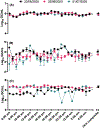Intraday variability of indicator and pathogenic viruses in 1-h and 24-h composite wastewater samples: Implications for wastewater-based epidemiology
- PMID: 33249042
- PMCID: PMC8267967
- DOI: 10.1016/j.envres.2020.110531
Intraday variability of indicator and pathogenic viruses in 1-h and 24-h composite wastewater samples: Implications for wastewater-based epidemiology
Abstract
We monitored the concentration of indicator viruses crAssphage and pepper mild mottle virus (PMMoV) and human pathogen adenovirus (HAdV) in influent from a wastewater treatment plant in Brisbane, Australia in 1-h and 24-h composite samples. Over three days of sampling, the mean concentration of crAssphage gene copies (GC)/mL in 24-h composite samples did not differ significantly (p = 0.72-0.92), while for PMMoV GC/mL (p value range: 0.0002-0.0321) and HAdV GC/mL (p value range: 0.0028-0.0068) significant differences in concentrations were observed on one day of sampling compared to the other two. For all three viruses, the variation observed in 1-h composite samples was greater than the variation observed in 24-h composite samples. For crAssphage, in 54.1% of 1-h composite samples, the concentration was less than that observed in 24-h composite samples; whereas for PMMoV and HAdV the concentration was less in 79.2 and 70.9% of 1-h composite samples, respectively, compared to the relevant 24-h composite samples. Similarly, the concentration of crAssphage in 1-h compared to 24-h composite samples did not differ (p = 0.1082) while the concentrations of PMMoV (p < 0.0001) and HAdV (p < 0.0001) in 1-h composite samples were significantly different from 24-h composite samples. These results suggest that 24-h composite samples offer increased analytical sensitivity and decreased variability compared to 1-h composite samples when monitoring wastewater, especially for pathogenic viruses with low infection rates within a community. Thus, for wastewater-based epidemiology applications, 24-h composite samples are less likely to produce false negative results and erroneous public health information.
Keywords: Enteric viruses; Enveloped viruses; Epidemiology; Human health risks; Surveillance; WBE; Wastewater.
Crown Copyright © 2020. Published by Elsevier Inc. All rights reserved.
Figures
References
-
- Ahmed W, Angel N, Edson J, Bibby K, Bivins A, O’Brien JW, Choi PM, Kitajima M, Simpson SL, Li J, Tscharke B, Verhagen R, Smith WJM, Zaugg J, Dierens L, Hugenholtz P, Thomas KV, Mueller JF, 2020a. First confirmed detection of SARS-CoV-2 un untreated wastewater in Australia: a proof of concept for the wastewater surveillance of COVID-19 in the community. Sci. Total Environ 728, 138764. - PMC - PubMed
-
- Ahmed W, Bertsch PM, Bibby K, Haramoto E, Hewitt J, Huygens F, Gyawali P, Korajkic A, Riddel S, Sherchan SP, Simpson SL, Sirikanchana K, Symonds EM, Verhagen R, Vasan SS, Kitajima M, Bivins A, 2020b. Decay of SARS-CoV-2 and surrogate murine hepatitis virus RNA in untreated wastewater to inform application in wastewater-based epidemiology. Environ. Res 191, 110092. - PMC - PubMed
-
- Besselsen DG, Wagner AM, Loganbill JK, 2002. Detection of rodent coronaviruses by use of fluorogenic reverse transcriptase-polymerase chain reaction analysis. Comp. Med 52 (2), 111–116. - PubMed
Publication types
MeSH terms
Substances
Grants and funding
LinkOut - more resources
Full Text Sources
Other Literature Sources
Miscellaneous



